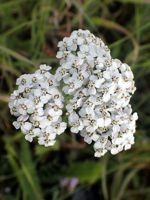Mon-Fri 9am - 5pm Mountain time
Yarrow vs Hairy Golden Aster
Achillea borealis (Previously Achillea millefolium)
Heterotheca villosa
SOLD OUT
NOT AVAILABLE THIS SEASON - MIGHT RETURN
Yarrow is a herbaceous, native wildflower that is found across Canada. It features large, flat clusters of tiny white flowers. The blooms attract a variety of pollinators, making it an ideal choice for pollinator gardens. While partial shade is tolerated, the best flowering occurs in full sun. Yarrow is resistant to deer and rabbits, making it both a beautiful and practical addition to your landscape.
The entire plant is edible, but leaves and flowers are most commonly consumed. They have a strong licorice scent and a mild sweet flavor that is similar to tarragon. Yarrow leaves can also be used as a natural insect repellent.
It is important to plant Yarrow in the right place, it can spread quickly via both rhizomes and self-seeding. Deadheading the spent flowers will extend the bloom season and can help limit self-seeding.
Hairy Golden Aster is a native perennial wildflower known for its clusters of bright yellow, daisy-like blooms. They bloom from mid-summer into fall, providing late-season colour and a valuable nectar source for pollinators, including a variety of bee species.
Flowers mature into fluffy seed heads and can self-seed readily. Removing spent blooms helps manage their spread, but some people will choose to leave a few seed heads to provide food for birds. Hairy Golden Aster grow in bushy clumps, tolerates poor sandy soils, and once established, are among the most drought-tolerant wildflowers. They are well-suited for pollinator gardens, restoration, naturalization, and xeriscaping projects.
Yarrow Quick Facts
Hairy Golden Aster Quick Facts
Toxicity: toxic to dogs, cats, and horses

